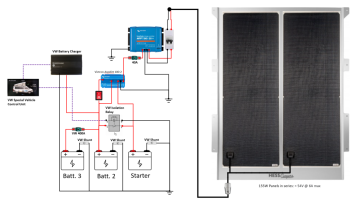Wiring Diagram of my 310W solar install on a VW California Ocean. Anything marked VW is VW OEM equipment, the rest is available on t'internet.

I am in the process of building and fitting. (Fusing is not yet finally decided as it depends on component locations, wire lengths etc.)
Notes:
Due to the panel size and my preference for Victron kit, I chose a SmartSolar MPPT 100/30. The Victron website suggested a 100/20 but it would throttle the charge current to 20A with a 310W solar setup which is wasting energy.
I have tested series/parallel on my sailing boat (also a 300W system) and over two 7 day periods in the Adriatic it made no discernable difference to the daily yield - the mast, boom, and sails regularly shade the panels. I therefore settled on series as it pulls the voltage well above the startup voltage of the MPPT and generates less current, therefore less loss in the solar panel wiring for a given wire size. As my panels came with 2.5 mm2 wiring, they will be wired in series.
The SmartSolar MPPT 100/30 only has one output so charging both the starter and leisure batteries from it was going to be a challenge.
VW has an Isolation Relay controlled by the VW Special Vehicle Control Unit and the VW Battery Charger ... it sits between the Starter Battery and the Leisure Batteries. This means I either bridge the relay (not good on modern cars because of recuperation and stop/start) or I have to find a way to charge both battery banks independently with no current transfer between the two charging circuits (unless the VW components decide it is safe to close the relay - which is OK.)
To do this I am fitting a 2 output 100 Amp Victron Argofet. One output goes to the leisure batteries, the other to the starter battery and they will be isolated from each other. The fly in the ointment is that the Victron MPPT will also be isolated and therefore will not power up - fortunately, this can be solved by applying 12v to the "Energize" input to the Argofet. When this input is switched live, it will provide 12V to the Victron MPPT - the function was designed for use with the exciter coils on an alternator but will work fine (hopefully) with the MPPT too.
... any comments or observations welcome.

I am in the process of building and fitting. (Fusing is not yet finally decided as it depends on component locations, wire lengths etc.)
Notes:
Due to the panel size and my preference for Victron kit, I chose a SmartSolar MPPT 100/30. The Victron website suggested a 100/20 but it would throttle the charge current to 20A with a 310W solar setup which is wasting energy.
I have tested series/parallel on my sailing boat (also a 300W system) and over two 7 day periods in the Adriatic it made no discernable difference to the daily yield - the mast, boom, and sails regularly shade the panels. I therefore settled on series as it pulls the voltage well above the startup voltage of the MPPT and generates less current, therefore less loss in the solar panel wiring for a given wire size. As my panels came with 2.5 mm2 wiring, they will be wired in series.
The SmartSolar MPPT 100/30 only has one output so charging both the starter and leisure batteries from it was going to be a challenge.
VW has an Isolation Relay controlled by the VW Special Vehicle Control Unit and the VW Battery Charger ... it sits between the Starter Battery and the Leisure Batteries. This means I either bridge the relay (not good on modern cars because of recuperation and stop/start) or I have to find a way to charge both battery banks independently with no current transfer between the two charging circuits (unless the VW components decide it is safe to close the relay - which is OK.)
To do this I am fitting a 2 output 100 Amp Victron Argofet. One output goes to the leisure batteries, the other to the starter battery and they will be isolated from each other. The fly in the ointment is that the Victron MPPT will also be isolated and therefore will not power up - fortunately, this can be solved by applying 12v to the "Energize" input to the Argofet. When this input is switched live, it will provide 12V to the Victron MPPT - the function was designed for use with the exciter coils on an alternator but will work fine (hopefully) with the MPPT too.
... any comments or observations welcome.








